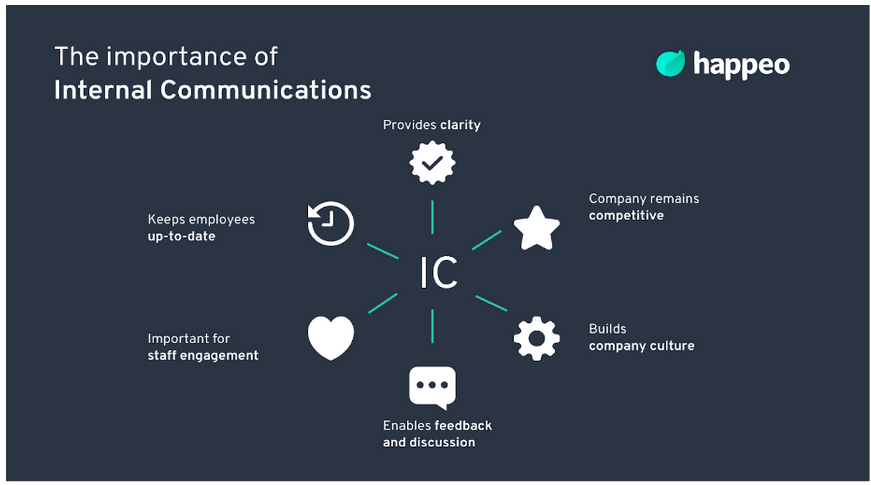Internal communication

Internal communication is the function responsible for effective communications among participants within an organization. The scope of the function varies by organization and practitioner, from producing and delivering messages and campaigns on behalf of management, to facilitating two-way dialogue and developing the communication skills of the organization’s participants (Wikipedia, 2021).
Internal communication has been constantly recognized by management communication and public relations scholars and practitioners as a key area of public relations, growing in importance (Verčič and Špoljarić, 2020; Men and Yue, 2019).
7 reasons why internal communication is important (Moseley, 2020)
- Keeps people informed.
- Gives people a more holistic view of the organisation.
- Helps build out the organisation’s culture.
- Gets people engaged.
- Helps keep people calm in time of crisis.
- Creates another dimension at workplace.
- Creates a channel for feedback, debate, and discussion.

The importance of Internal Communications (Happeo, 2021).
Communication, as an essential organizational component, must be included in the parameters of effectiveness, for both external and internal context (Kurti and Dollani, 2019).
Moreover, to develop efficient internal communications the following skills are required: ability to say “no”, ability to collaborate, consistency, audience focus, and listening skills. (https://www.skillsyouneed.com/rhubarb/internal-communications-strategy.html)
Which are the main communication channels
Communication, as an essential organizational component, must be included in the parameters of effectiveness, for both external and internal context (Kurti and Dollani, 2019). Modern companies and organizations use a whole range of channels to reach their internal audiences – from traditional, face-to-face communication to printed publications, electronic media and social networks (Verčič and Špoljarić, 2020). Employees at all levels are required to be familiar with all (or most) of these different communication methods. In order to be able to advance your chances to enter the labour market, you should be able to develop your skills for the most common communication channels used by modern companies nowadays, such as: 1) face-to-face communication skills, 2) use video conferencing, 3) use properly/professionally phone calls, 4) use emails, 5) use text messages, 6) use online messaging platforms, and 7) use social media (Dato, 2020). Companies choose the right communication channel for every message in order to have the business run efficiently, so you have to develop the appropriate skills to respond to these needs.
Which are the advantages of each communication channel
Each communication channel has its advantages and disadvantages. The advantages of each communication channel are presented and discussed in this section.
- Face-to-face communication: Face-to-face is still the preferred communication channel if clarity of message is a primary factor. Communication in person allows you to interact with the listener in a back-and-forth discussion. It also allows you to utilize nonverbal gestures, facial expressions and personal charisma to enhance the message (Kokemuller, 2018).
- Videoconferencing: Video calls enable quick screen sharing and reduce travel time, retains your ability to read facial expressions while increasing flexibility and allows for complex or lengthy conversations (Podium, 2020).
- Phone calls: Phone calls are a great alternative when you need to communicate a sense of urgency and get answers quickly. Calls are a real-time, two-way communication channel that still let you hear tone of voice (Podium, 2020).
- Emails: E-mail allows for more flexible response times. You can send a message one day and receive a response in a few hours or the next day. It allows for conversation that isn’t time-pressured, but can serve for fast turnaround times (Kokemuller, 2018).
- Text messages: SMS text messaging is an active communication channel that offers flexibility when it comes to send essential messages or information quickly (Avochato, 2021).
- Social media: Provide clear social media policies and employee training; empower employee social advocates; involve leadership and secure endorsement; social media listening; sharable, relevant, and practical content strategies; and, authenticity and consistency (Ewing, 2019).
Activity
Name of the activity:
Emergency event
The aim of the activity:
The goal of the activity is to help participants put themselves in an employer’s shoes and decide the communication channel(s) to be used in a given scenario. Its objective is for participants to acquire a different point of view and realise the importance of internal communication.
Skills that the activity develops:
Critical thinking, active listening, discussion and argumentation
How many people the activity is suited for:
There is no maximum but there is a minimum of 2.
Time requirement for the activity:
15-20 minutes.
How many instructors are needed:
1
Other requirements for the activity:
According to the number of participants there should be enough space, so that they can all look one another, in order to develop a fruitful debate/dialogue.
Describe the activity in a clear and concise manner:
All the participants sit in a way (maybe in a circle), so that they can look one another and have a clear view. The instructor asks the participants to listen to the scenario described/attached below. Then, the team has to decide which communication channels could be used in order to transfer the message internally in the organization; also, the importance of internal communication for an organization has to be considered and discussed.
Scenario:
“The company revenues are decreasing, and the Board of Directors decided to proceed with a) salary cut for all staff by 15%, and b) workforce reduction by 10%. This is a final decision, which has to be communicated by HR to all staff, immediately”.
References
- Dato, N. (2020) 7 best communication channels for a connected team, Podium. Accessed at: https://www.podium.com/article/communication-channels/
- Happeo (2021) Guide to understanding & improving Internal Communications in your business, 22 June 2021. Accessed at: https://www.happeo.com/internal-communications-essentials
- Kurti, S. and Dollani, P. (2019) Employees’ perceptions on effective communication channels – A case study from Albanian banking sector, Economics and Culture, vol.16, no.1, 2019.
- Men, L.R. and Yue, C.A. (2019) Creating a positive emotional culture: Effect of internal communication and impact on employee supportive behaviors, Public Relations Review, vol.45, no.3, September 2019.
- Moseley, Corey (2020) 7 reasons why internal communications is important, Jostle blog. Assessed at: https://blog.jostle.me/blog/why-is-internal-communications-important
- Verčič, A.T. and Špoljarić, A. (2020) Managing internal communication: How the choice of channels affects internal communication satisfaction, Public Relations Review, vol.46, no.3, September 2020.
- Wikipedia (2021) Internal communications. Accessed at: https://en.wikipedia.org/wiki/Internal_communications
- “SME Insights: Why You Should
Pay Attention to Internal Communications”, © 2011 – 2021 SkillsYouNeed.com, Retrieved November 23, 2021, from https://www.skillsyouneed.com/rhubarb/internal-communications-strategy.html.

